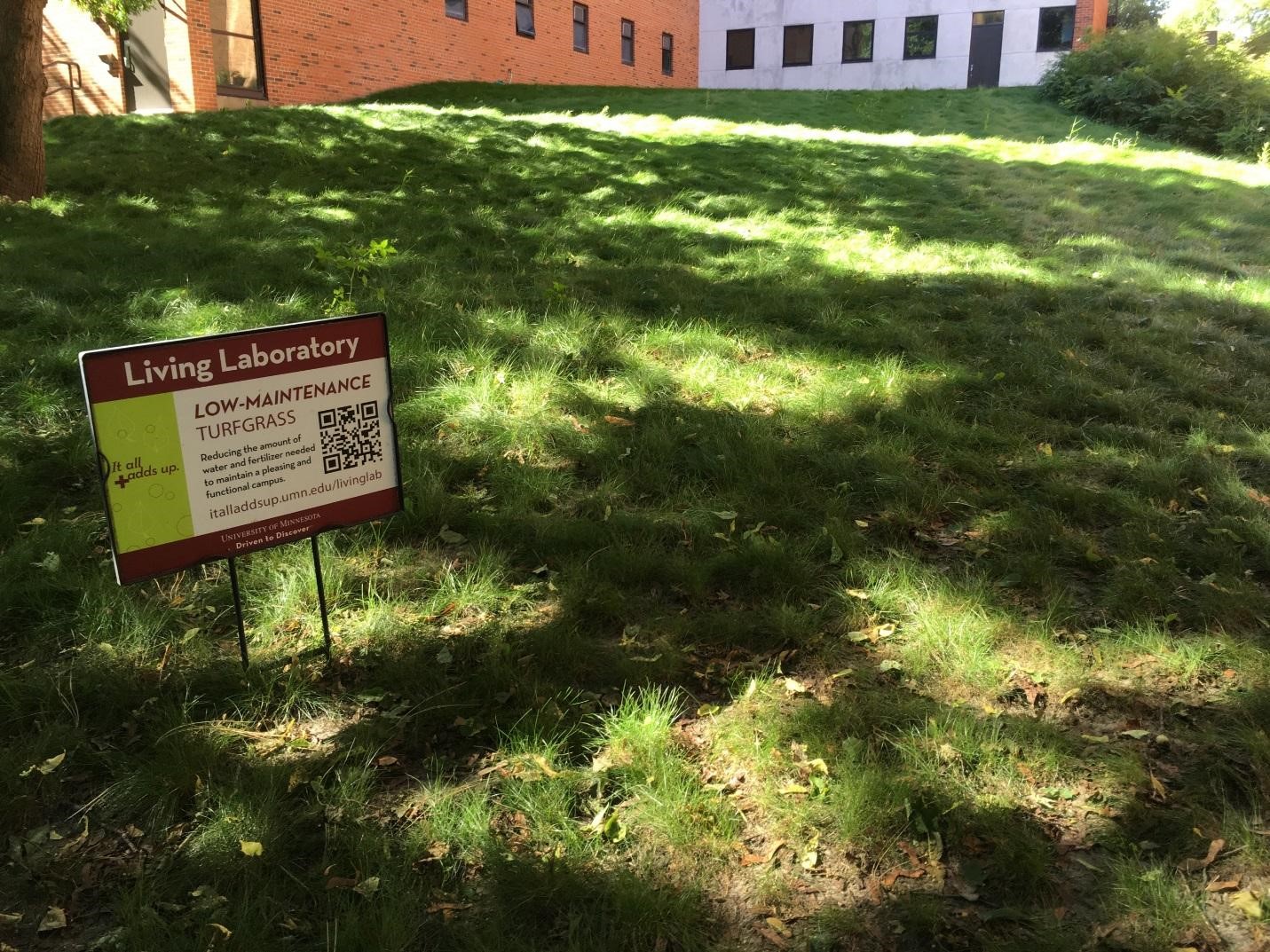By David Herrera
NASA scientist Cristina Milesi estimates that there is three times the amount of turfgrass in the United States as there are acres of irrigated corn [1]. When we consider that the rate of grass seed density required for turf can be up to 6 lbs per 1000 sq.ft, one can imagine the enormous quantity of seed needed to plant all that turf! Most of that planted grass seed is, at least here in the Midwest, Kentucky bluegrass. However, there is a grass genus that has gained interest and may one day be used just as much or more as Kentucky bluegrass. These newcomers are in the genus Festuca, and are commonly known as the fine fescues.
Fine fescue mix growing under shaded and low-irrigation conditions just outside of Alderman Hall, St. Paul Campus. Fine fescue is drought tolerant and requires little fertilizer input, though it is sensitive to heat and physical wear. Photo by David R. Herrera.
Fine fescues, with their slow growing nature, higher shade tolerance, and low fertilization requirements, are phenomenal low-input turfgrasses that can keep homeowners and other turf enthusiasts happy. So why are the fine fescues not as commonplace as one would think? The answer could be rooted in seed availability and public education. It has been established that those interested in maintaining a functional turf system are willing to pay more for a species that is lower input [2]. However, seed simply is not always readily available, and, to most, knowledge of lower input turfgrasses is quite limited.
Seed production is currently lacking for the fine fescues in the United States. Oregon’s Willamette Valley is a hot spot for national grass seed production; even so, according to a 2013 review, a mere 5% of that was fine fescue [3]. Minnesota has its own little hot spot of grass seed producers. The northerly town of Roseau, just minutes west of Lake of the Woods, is home to a fair amount of perennial ryegrass seed production. In the last few decades, perennial ryegrass has been the only turf seed crop produced there, but now that the demand and interest for lower input turf grasses has grown, it might make way for the fine fescue seed production.
As a graduate student in turfgrass science at the University of Minnesota, I am investigating the nitrogen fertilizer requirements for various fine fescue species when grown for seed. Since yield is critical for commercial seed producers, understanding seed yields can be the first step for Minnesota seed producers to adopt and grow these new grass species. Currently, we have a research plot at the Magnusson Research Farm in Roseau with varying nitrogen treatments. We are taking small samples in these plots to try to extrapolate seed yields in a larger scale seed producing operation. We will determine if there are any trends with nitrogen and seed yield; perhaps we can discover an optimal range of nitrogen fertilizer that should be applied. This nitrogen study is being repeated at two other locations – Becker, MN and St. Paul, MN – and features five species of fine fescue: hard fescue, Chewings fescue, slender creeping red fescue, strong creeping red fescue, and sheep fescue.
Another way farmers can add value to their seed is by having high levels of purity in seed lots. Grass seed that is free of noxious weeds can have a higher price on the market, which ultimately translates into a higher incentive for Minnesota grass seed producers to start up production. To study how we can help farmers increase seed purity, we are testing a number of different herbicides for weed control in seed production fields. This is an effort to determine which herbicide, or herbicide combination, is effective for weed control while maintaining an adequate yield.
We hope to obtain better insight as to how fine fescue seed production might occur in Midwestern climate and soils. We strive to have Minnesota produce high-quality, low input, turfgrass seed for consumers to enjoy. Perhaps, in the near future, fine fescue can become as commonplace and beloved as Kentucky bluegrass.
For more information about this project, please feel free to email me at [email protected].
References:
[1] https://earthobservatory.nasa.gov/Features/Lawn/
[2] C. Yue, K. Hugie, E. Watkins, Are consumers willing to pay more for low-input turfgrasses on residential lawns? Evidence from choice experiments. Journal of Agricultural and Applied Economics 44, (2012).
[3] S. A. Bonos, D. R. Huff, Cool-Season Grasses: Biology and Breeding. Turfgrass: Biology, Use, and Management 56, 591-660 (2013).
